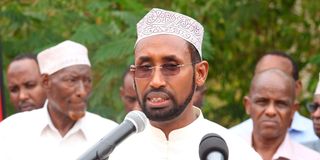Help governors in counties hit by the drought

Mandera Governor Mohamed Adan Khalif. His Elimu Kwa Wote initiative targeting over 22,000 students will not only alleviate the suffering wrought by the drought but also offer hope for a brighter future for many families.
The unprecedented drought that has been ravaging much of Kenya has hit counties in arid and semi-arid lands (Asal) hard, with governors—as the first responders on the ground—having to spend greater portions of their scarce resources to save lives and livelihoods.
While the magnitude of the problem in the north can only be solved with the aid of the national government, non-governmental organisations and the international community, the county bosses can prioritise the residents’ needs to blunt its impact.
The north needs a Marshall Plan—massive investments to bring it at par with or even close to the rest of the country.
Named for Secretary of State George Marshall, who in 1947 proposed that the United States provide economic assistance to restore the economic infrastructure of post-war Europe, President Harry Truman signed the Economic Recovery Act on April 3, 1948, which opened the gates for fast development of stable democratic governments in Western Europe while providing markets for American goods.
A developed north, with great potential in agriculture, oil and gas, domestic trade and tourism, will contribute in a big way to the development of Kenya. Under the Kenya Vision 2030, the national government is supposed to, among other things, protect citizens.
Marginalised
That the counties formerly known as the Northern Frontier District (NFD) have got the short end of the stick since Independence is well documented. What remains to be done is the full redress of this great injustice. While the onset of devolution was the beginning of equitable development for all regions, the delayed full realisation of the Equalization Fund has remained a blot on the otherwise brilliant face of the new Kenya.
A permanent solution to water shortages and a developed livestock industry value chain that includes meat processing and tanneries, as well as a reliable power supply and a revamped road network, is what the north needs for rapid take-off.
Article 204 of the Constitution pegs the share of the Equalization Fund at 0.5 per cent of national revenue. Yet, a decade since the onset of devolution, close to Sh30 billion has not been disbursed due to delays in formulating guidelines, late project identification and legislative hurdles. This amount has pended for 2011/12 to 2019/20 Financial Years.
That is why moves such as the decision by Mandera Governor Mohammed Adankhalif to pay tuition fees for all students enrolled in the vast county’s 59 public secondary schools are laudable.
The Elimu Kwa Wote initiative targeting over 22,000 students will not only alleviate the suffering wrought by the drought but also offer hope for a brighter future for many families. Education is a great equaliser.
Mr Adankhalif has set aside Sh350 million for the programme this fiscal year. Although that will ease the effects of the drought for low-income families, it will squeeze the meagre resources of the county.
Mr Adankhalif is a disaster risk management consultant. [email protected].





